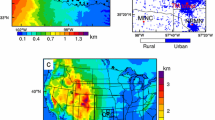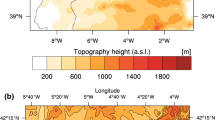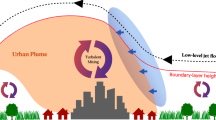Abstract
A number of open questions remain regarding the role of low-level jets (LLJs) and nocturnal mixing processes in the buildup of tropospheric ozone. The prevalence of southerly winds and LLJs in the U.S. Southern Great Plains during summer makes this region an ideal site for investigating the structure of the nocturnal boundary layer and its impacts on urban air quality. Ozone \((\mathrm{O}_{3})\) and nitrogen oxide concentrations measured at regulatory monitoring sites in the Oklahoma City (OKC) area and simulations with the Weather Research and Forecasting with Chemistry (WRF/Chem) model were analyzed to show how the nocturnal LLJ moderates boundary-layer mixing processes and air quality. Datasets collected during the Joint Urban 2003 campaign, which took place in July 2003 in OKC, provided detailed information about nocturnal boundary-layer structure and dynamics. In general, \({\mathrm{O}_{3}}\) time series show the expected behavior that urban \({\mathrm{O}_{3}}\) concentrations decrease at night due to nitrogen oxide titration reactions, but elevated \({\mathrm{O}_{3}}\) concentrations and secondary \({\mathrm{O}_{3}}\) peaks are also seen quite frequently after sunset. LLJs developed on most nights during the study period and were associated with strong vertical wind shear, which affected the boundary-layer stability and structure. Near-surface \({\mathrm{O}_{3}}\) concentrations are higher during less stable nights when active mixing persists throughout the night. The WRF/Chem model results agree well with the observations and further demonstrate the role of LLJs in moderating nocturnal mixing processes and air quality. The highest nocturnal \({\mathrm{O}_{3}}\) concentrations are linked to a strong LLJ that promotes both nocturnal long-range transport and persistent downward mixing of \({\mathrm{O}_{3}}\) from the residual layer to the surface.










Similar content being viewed by others
References
Acevedo OC, Fitzjarrald DR (2001) The early evening surface-layer transition: temporal and spatial variability. J Atmos Sci 58:2650–2667
Allwine KJ (2004) Overview of JOINT URBAN 2003—an atmospheric dispersion study in Oklahoma City. In: Symposium on planning, nowcasting, and forecasting in the Urban Zone, Seattle, WA. American Meteorological Society, Boston
Athanassiadis GA, Rao ST, Clark RD (2002) Boundary layer evolution and its influence on ground-level ozone concentrations. Environ Fluid Mech 2:339–357
Balsley BB, Svensson G, Tjernstrom M (2008) On the scale-dependence of the gradient Richardson number in the residual layer. Boundary-Layer Meteorol 127:57–72
Banta RM, Mahrt L, Vickers D, Sun J, Balsley B, Pichugina Y, Williams E (2007) The very stable boundary layer on nights with weak low-level jets. J Atmos Sci 64:3068–3090
Banta RM, Pichugina YL, Brewer WA (2006) Turbulent velocity-variance profiles in the stable boundary layer generated by a nocturnal low-level jet. J Atmos Sci 63:2700–2719
Banta RM, Pichugina YL, Newsom RK (2003) Relationship between low-level jet properties and turbulence kinetic energy in the nocturnal stable boundary layer. J Atmos Sci 60:2549–2555
Banta RM, Senff CJ, White AB, Trainer M, McNider RT, Valente RJ, Mayor SD, Alvarez RJ, Hardesty RM, Parish DD, Fehsenfeld FC (1998) Daytime buildup and nighttime transport of urban ozone in the boundary layer during a stagnation episode. J Geophys Res D 103:22519–22544
Bloomer BJ, Vinnikov KY, Dickerson RR (2010) Changes in seasonal and diurnal cycles of ozone and temperature in the eastern U.S. Atmos Environ 44:1–9
Brown SS, Neuman JA, Ryerson TB, Trainer M, Dube WP, Holloway JS et al (2006) Nocturnal odd-oxygen budget and its implications for ozone loss in the lower troposphere. Geophys Res Lett 33:8
Chen F, Dudhia J (2001) Coupling an advanced land surface hydrology model with the Penn State-NCAR MM5 modeling system. Part I: model implementation and sensitivity. Mon Weather Rev 129:569–585
De Wekker SFJ, Berg LK, Allwine KJ, Doran JC, Shaw WJ (2004) Boundary-layer structure upwind and downwind of Oklahoma City during the Joint Urban 2003 field study. In: 5th symposium on the urban environment, Vancouver, BC. American Meteorological Society, Boston
Dudhia J (1989) Numerical study of convection observed during the winter monsoon experiment using a mesoscale twodimensional model. J Atmos Sci 46:3077–3107
Eliasson I, Thorsson S, Andersson-Skolfd Y (2003) Summer nocturnal ozone maxima in Goteborg, Sweden. Atmos Environ 37:2615–2627
Emmons LK et al (2010) Description and evaluation of the model for ozone and related chemical tracers, version 4 (MOZART-4). Geosci Model Dev 3:43–67
Environmental Protection Agency (EPA) (2010) Our Nation’s air. Status and trends through 2008. EPA -454/R-09-002, http://www.epa.gov/airtrends/2010/report/fullreport.pdf. Access 16 Jan 2011
Fitzjarrald DR, Moore KE (1994) Growing season boundary layer climate and surface exchanges in subarctic lichen woodland. J Geophys Res D 99:1899–1917
Geyer A, Stutz J (2004a) Vertical profiles of NO\(_3\), N\(_2\)O\(_5\), O\(_3\), and NO\(_{x}\) in the nocturnal boundary layer: 2. Model studies on the altitude dependence of composition and chemistry. J Geophys Res 109. doi:10.1029/2003JD004211
Geyer A, Stutz J (2004b) The vertical structure of \(\text{ OH-HO }_{2}\text{-RO }_{2}\) chemistry in the nocturnal boundary layer: a one-dimensional model study. J Geophys Res D 109. doi:10.1029/2003JD004425
Gouveia FJ, Leach MJ, Shinn JH, Ralph WE (2007) Use of a large crane for wind and tracer profiles in an urban setting. J Atmos Oceanic Technol 24:1750–1756
Grimmond CSB, Su H-B, Offerle B, Crawford B, Scott S, Zhong S, Clements C (2004) Variability of sensible heat fluxes in a suburban area of Oklahoma City. In: Symposium on planning, nowcasting, and forecasting in the urban zone, Seattle, WA. American Meteorological Society, Boston
Guenther A, Zimmerman P, Wildermuth M (1994) Natural volatile organic compound emission rate estimates for U.S. woodland landscapes. Atmos Environ 28:1197–1210
Hidy GM (2000) Ozone process insights from field experiments part I: overview. Atmos Environ 34:2001–2022
Higgins RW, Yao Y, Yarosh ES, Janowiak JE, Mo KC (1997) Influence of the Great Plains low-level jet on summertime precipitation and moisture transport over the central United States. J Clim 10:481–507
Hong S-Y, Dudhia J, Chen S-H (2004) A revised approach to ice microphysical processes for the bulk parameterization of cloud and precipitation. Mon Weather Rev 132:103–120
Hong S-Y, Noh Y, Dudhia J (2006) A new vertical diffusion package with explicit treatment of entrainment processes. Mon Weather Rev 134:2318–2341
Hu X-M, Doughty DC, Sanchez KJ, Joseph E, Fuentes JD (2012) Ozone variability in the atmospheric boundary layer in Maryland and its implications for vertical transport model. Atmos Environ 46:354–364
Hu X-M, Klein P, Xue M, Zhang F, Doughty D, Forkel R, Joseph E, Fuentes JD (2013a) Impact of the vertical mixing induced by low-level jets on boundary layer ozone concentration. Atmos Environ 70:123–130
Hu X, Klein P, Xue M, Lundquist J, Zhang F, Qi Y (2013b) Impact of low-level Jets on the nocturnal urban heat island intensity in Oklahoma City. J Appl Meteorol Climatol. doi:10.1175/JAMC-D-12-0256.1
Hu X-M, Klein PM, Xue M, Shapiro A, Nallapareddy A (2013c) Enhanced vertical mixing associated with a nocturnal cold front passage and its impact on near-surface temperature and ozone concentration. J Geophys Res 118:2714–2728
Kastner-Klein P, Williams D, Hall F (2002) Impact of long-range transport on ozone pollution in the Oklahoma City metropolitan area. In: 12th joint conference on the applications of air pollution meteorology with the air and waste management association, May 20–24, Norfolk, VA, USA
Lundquist JK, Mirocha JD (2008) Interaction of nocturnal low-level jets with urban geometries as seen in joint urban 2003 data. J Appl Meteorol Climatol 47:44–58
McPherson RA, Fiebrich C, Crawford KC, Elliott RL, Kilby JR, Grimsley DL, Martinez JE, Basara JB, Illston BG, Morris DA, Kloesel KA, Stadler SJ, Melvin AD, Sutherland AJ, Shrivastava H (2007) Statewide monitoring of the mesoscale environment: a technical update on the Oklahoma Mesonet. J Atmos Oceanic Technol 24:301–321
Mlawer EJ, Taubman SJ, Brown PD, Iacono MJ, Clough SA (1997) Radiative transfer for inhomogeneous atmospheres: RRTM, a validated correlated-k model for the longwave. J Geophys Res 102D:16663–16682
Neu U, Kunzle T, Wanner H (1994) On the relation between ozone storage in the residual layer and daily variation in near-surface ozone concentration—a case study. Boundary-Layer Meteorol 69:221–247
Oke TR (1982) The energetic basis of the urban heat island. Q J R Meteorol Soc 108:1–24
Parish TR, Oolman LD (2010) On the role of sloping terrain in the forcing of the great plains low-level jet. J Atmos Sci 67:2690–2699
Philbrick CR, Ryan WF, Clark RD, Doddridge BG, Hopke PK, McDow SR (2003) Advances in understanding urban air pollution from the NARSTO-NEOPS program. In: 5th conference on atmospheric chemistry: gases, aerosols, and clouds, American Meteoroloical Society, 8–13 February 2003, Long Beach, CA
Pleim JE (2011) Comment on “Simulation of surface ozone pollution in the central Gulf coast region using WRF/Chem model: sensitivity to PBL and land surface physics”. Adv Meteorol. doi:10.1155/2011/464753
Reitebuch O, Strassburger A, Emeis S, Kuttler W (2000) Nocturnal secondary ozone concentration maxima analysed by sodar observations and surface measurements. Atmos Environ 34:4315–4329
Samson PJ (1978) Nocturnal ozone maxima. Atmos Environ 12:951–955
Skamarock WC, Coauthors (2008) A description of the advanced research WRF version 3. NCAR technical note TN-475_STR, 113 pp
Solomon P, Cowling E, Hidy G, Furiness C (2000) Comparison of scientific findings from major ozone field studies in North America and Europe. Atmos Environ 34:1885–1920
Song J, Liao K, Coulter RL, Lesht BM (2005) Climatology of the low-level jet at the Southern Great Plains atmospheric boundary layer experiments site. J Appl Meteorol 44:1593–1606
Stockwell WR, Kirchner F, Kuhn M, Seefeld S (1997) A new mechanism for regional atmospheric chemistry modeling. J Geophys Res 102:25847–25879
Stutz J, Alicke B, Ackermann R, Geyer A, White A, Williams E (2004) Vertical profiles of \(\text{ NO }_{3}, \text{ N }_{2}\text{ O }_{5}, \text{ O }_{3}\), and \(\text{ NO }_{{\rm x}}\) in the nocturnal boundary layer: 1. Observations during the Texas air quality study 2000. J Geophys Res 109. doi:10.1029/2003JD004209
Stutz J, Wong KW, Lawrence L, Ziemba L, Flynn JH, Rappenglück B, Lefer B (2009) Nocturnal \(\text{ NO }_{3}\) radical chemistry in Houston, TX. Atmos Environ. doi:10.1016/j.atmosenv.2009.03.004
Tong NYO, Leung DYC, Liu CH (2011) A review on ozone evolution and its relationship with boundary layer characteristics in urban environments. Water Air Soil Pollut. 214:13–36
Velasco E, Marquez C, Bueno E, Bernabe RM, Sanchez AO, Fentanes HW et al (2008) Vertical distribution of ozone and VOCs in the low boundary layer of Mexico City_acp-8-3061-2008. Atmos Chem Phys 8:3061–3079
Wexler H (1961) A boundary layer interpretation of the low-level jet. Tellus 13:368–378
Whiteman CD, Bian X, Zhong S (1997) Low-level jet climatology from enhanced rawinsonde observations at a site in the southern Great Plains. J Appl Meteorol 36:1363–1376
Zhang J, Rao ST (1999) The role of vertical mixing in the temporal evolution of ground-level ozone concentrations. J Appl Meteorol 38:1674–1691
Zhong S, Fast JD, Bian X (1996) A case study of the Great Plains low-level jet using wind profiler network data and a high-resolution mesoscale model. Mon Weather Rev 124:785–806
Acknowledgments
This study was supported by funding from the Office of the Vice President for Research at the University of Oklahoma and through the NSF Career award ILREUM (NSF ATM 0547882). The JU2003 experiments were funded by the Defense Threat Reduction Agency’s Urban Dispersion Modeling program managed by John Pace and Rick Fry. Oklahoma’s taxpayers fund the Oklahoma Mesonet through the Oklahoma State Regents for Higher Education and the Oklahoma Department of Public Safety. The authors would also like to thank Leon Ashford from the Department of Environmental Quality in OKC for his support in obtaining the air-quality data, Jeffrey Basara and Brad Illston from the Oklahoma Climatological Survey for providing data from the Oklahoma Mesonet and for creating Fig. 1 for the manuscript, and three anonymous reviewers for their constructive and helpful comments.
Author information
Authors and Affiliations
Corresponding author
Rights and permissions
About this article
Cite this article
Klein, P.M., Hu, XM. & Xue, M. Impacts of Mixing Processes in Nocturnal Atmospheric Boundary Layer on Urban Ozone Concentrations. Boundary-Layer Meteorol 150, 107–130 (2014). https://doi.org/10.1007/s10546-013-9864-4
Received:
Accepted:
Published:
Issue Date:
DOI: https://doi.org/10.1007/s10546-013-9864-4




